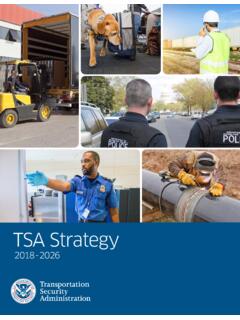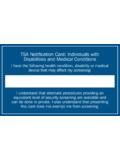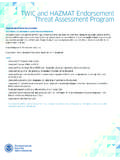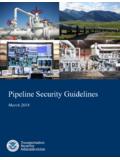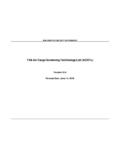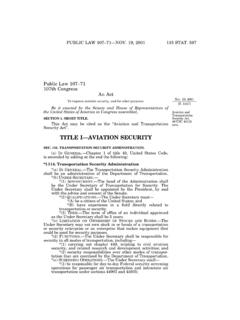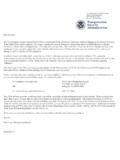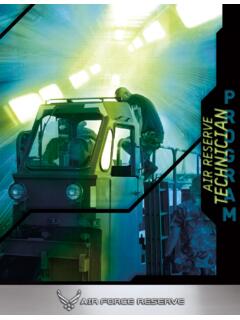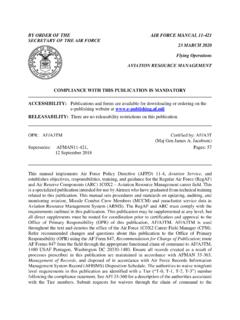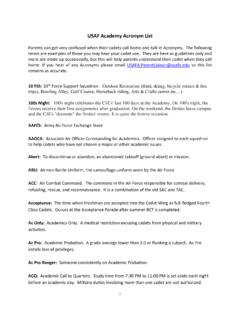Transcription of Security Guidelines for General Aviation Airport Operators ...
1 Security Guidelines for General Aviation Airport Operators and Users Information Publication A-001, Version 2 July 2017 2 [Back of cover] 3 Table of Contents EXECUTIVE SUMMARY .. 5 1. 6 2. ABOUT General Aviation .. 7 3. GA VULNERABILITY .. 8 4. INTRODUCTION TO RISK-BASED Security .. 9 5. GATHERING 9 IDENTIFYING THE THREAT .. 10 EIGHT SIGNS OF TERRORISM .. 10 PEOPLE .. 12 AIRCRAFT .. 12 INFRASTRUCTURE .. 12 Airport Security Assessment and Protective Measures Matrix .. 12 6. SUGGESTED Airport Security ENHANCEMENTS .. 13 PEOPLE .. 14 Passengers/Visitors .. 14 Flight Schools/Student Pilots .. 14 Aircraft Renters .. 15 Transient 15 AIRCRAFT .. 15 INFRASTRUCTURE .. 16 Hangars .. 16 Locks .. 16 Key Control .. 18 Perimeter Security .. 18 Closed Circuit Television (CCTV).
2 19 Intrusion Detection Systems (IDS) .. 19 Fencing .. 19 Access 21 Gates .. 21 Lighting .. 22 Signage .. 24 Identification System .. 24 Airport Planning .. 25 OTHER FACILITIES .. 25 Airport Tenant Facilities .. 25 Aircraft and Vehicle Fueling Facilities .. 26 Fuel Storage Equipment and Facilities .. 26 Military Facilities .. 27 Fixed-Base and Corporate-Based Operators (FBOs and CBOs) .. 27 7. Airport WATCH PROGRAMS .. 28 8. Security AWARENESS TRAINING .. 29 9. REPORTING PROCEDURES .. 30 10. Security PROCEDURES AND COMMUNICATIONS .. 30 LOCAL Airport Security COMMITTEE .. 32 LAW ENFORCEMENT OFFICER (LEO) 32 NATIONAL TERRORISM ADVISORY SYSTEM (NTAS) .. 32 THREAT COMMUNICATION SYSTEM .. 32 11. SPECIALTY operations .. 34 4 APPENDIX A Airport Security ASSESSMENT AND PROTECTIVE MEASURES MATRIX .. 35 APPENDIX B Airport Security PROGRAM TEMPLATE.
3 46 APPENDIX C BOMB THREAT CALL CHECKLIST .. 50 APPENDIX D BIBLIOGRAPHY .. 51 APPENDIX E USEFUL WEBSITES AND CONTACTS .. 55 Aviation TRADE ASSOCIATIONS .. 55 FEDERAL GOVERNMENT .. 55 FAA REGIONAL operations CENTERS .. 55 OTHER REFERENCES .. 56 5 EXECUTIVE SUMMARY This guidance document was developed jointly by the General Aviation (GA) community and the Transportation Security Administration (TSA). It is intended to provide GA Airport owners, Operators , sponsors, and entities charged with oversight of GA landing facilities, including tenants and/or users, with recommendations that address General Aviation Security concepts, technology, and enhancements. It provides a set of Security best practices and a method for determining when and where these enhancements would be appropriate. The application of recommended Security enhancements is based on the General Aviation community s analysis of perceived threats, areas of vulnerability, and risk assessments.
4 This document does not contain regulatory language nor is it intended to suggest that any recommendations or Guidelines should be considered mandatory. These recommendations and Guidelines are not intended to suggest any specific or General criteria to be met in order to qualify for Federal funding. Program requirements for Operators regulated under TSA s aircraft operator Security rules (for example, Twelve-Five and Private Charter operations ) are not addressed in this document. These Guidelines offer an extensive list of options, ideas, and suggestions for Airport owners, Operators , sponsors, and other entities charged with oversight of GA airports, including tenants and/or users to choose from when considering Security enhancements for GA facilities. This guidance can enhance consistency across the nation with regard to Security at GA facilities.
5 These Guidelines also provide a method to determine Security needs at different airports. Using a risk-based Security approach, an Airport operator can assess an Airport s Security characteristics and identify risks, threats, and vulnerabilities to decide which Security enhancements would be most appropriate. The intent of this document is to provide a tool to enable GA Airport managers to assess vulnerabilities and tailor appropriate Security measures to their environment. Most threats can be categorized as follows: Surveillance, Elicitation, Tests of Security , Funding, Supplies, Impersonation, Rehearsal, and Deployment. Members of the General Aviation community identified eight functional areas of General Aviation Security . The functional areas include: Risk-based methodology Personnel Aircraft Infrastructure: Airports/Facilities [ including fixed and corporate based Operators (FBOs/CBOs)] Surveillance Security Plans and Communications Specialty operations Tenants and Users Each of the functional areas is further broken down into detailed discussions of methods and strategies for enhancing General Aviation Security .
6 6 1. BACKGROUND Following the 1988 Pan American World Airways Flight 103 tragedy, a need existed for all segments of the Aviation industry to have input into future Aviation Security considerations. In response, the Aviation Security Advisory Committee (ASAC) was established in 1989 and was managed by the Federal Aviation Administration (FAA). After the terrorist attacks of September 11, 2001, Congress enacted the Aviation and Transportation Security Act (ATSA), which created TSA, to improve transportation Security . Consistent with this mission, Congress transferred FAA s civil Aviation Security responsibilities to TSA. Accordingly, sponsorship of the ASAC was also transferred to TSA. The ASAC was permanently established pursuant to the Aviation Security Stakeholder Participation Act of 2014 (Pub. L. 113-238, Dec. 18, 2014; 49 44946), including a General Aviation subcommittee.
7 TSA requested the ASAC to develop Guidelines for Security enhancements at the nation s private and public use GA landing facilities. TSA believed that such an approach would be able to address GA airports (both public and private use) in a collaborative forum in order to develop a set of community-endorsed Guidelines and best practices that are tailored to broad categories of airports and users. The working group represented the GA community as a whole. Participating members included: Aircraft Owners & Pilots Association (AOPA) Airports Council International North America (ACI-NA) Airport Consultants Council (ACC) American Association of Airport Executives (AAAE) Experimental Aircraft Association (EAA) GA Manufacturers Association (GAMA) Helicopter Association International (HAI) National Air Transportation Association (NATA) National Association of State Aviation Officials (NASAO) National Business Aviation Association (NBAA) National Association of Flight Instructors (NAFI) National Agricultural Aviation Association (NAAA) United States parachute Association (USPA) GA Airport managers and representatives of various state government Aviation agencies.
8 These Security Guidelines were initially developed as a collaborative effort between ASAC, GA stakeholders, and TSA to provide Airport owners, Operators , sponsors, and other entities charged with oversight of GA airports (including tenants and/or users), a set of mutually-endorsed Security enhancements. This is a living document, initially released in May 2004, refined with input from stakeholders as needed. This version (Version 2) was developed with consideration of lessons learned and experience gained since 2004. For the purposes of this document, General Aviation and Airport are defined as follows: General Aviation (GA), as used in this document, encompasses all civil Aviation , except military Aviation , and scheduled or chartered passenger and cargo service under TSA Security requirements in 49 CFR parts 1544 or 1546. Airport , as used in this document, means an area of land or water, or facility (heliport, 7 hospital, drilling rig etc.)
9 That is used or intended to be used for the landing and takeoff of aircraft, and includes its buildings and facilities if any. This document does not apply to airports required to comply with 49 CFR part 1542 or military To date there have been numerous initiatives undertaken by the GA community, such as awareness programs, challenge and reporting methods, and educational courses. This document incorporates these programs by reference as appropriate to the topic. In addition, these Guidelines recognize that every GA landing facility is unique. Therefore, the recommendations and Guidelines contained in this document may be highly beneficial in one Airport environment while being virtually impossible to implement at another. When stating in this document that a measure should be used, it means the measure is recommended to the extent it is consistent with the Airport s operational environment.
10 This document does not contain classified or Security sensitive information in order to enable its broad distribution to provide the greatest flexibility in creating an individualized template for all sizes of airports. 2. ABOUT General Aviation General Aviation operations encompass a variety of activities, which include: Corporate/business Aviation Personal/recreational flying Instruction/flight training Aerial application/crop dusting Aerial observation/search, rescue, law enforcement surveillance Air tours/air taxis Air medical/emergency services Skydiving/ parachute operations To accommodate this broad range of activities, and the equally broad range of related aircraft, GA airports vary in size, function, and operational characteristics. TSA understands that one size of Security does not fit all GA airports. For example, a privately owned landing strip in a rural area may not need to implement the same Security measures as a large, corporate Airport near a major metropolitan area.
